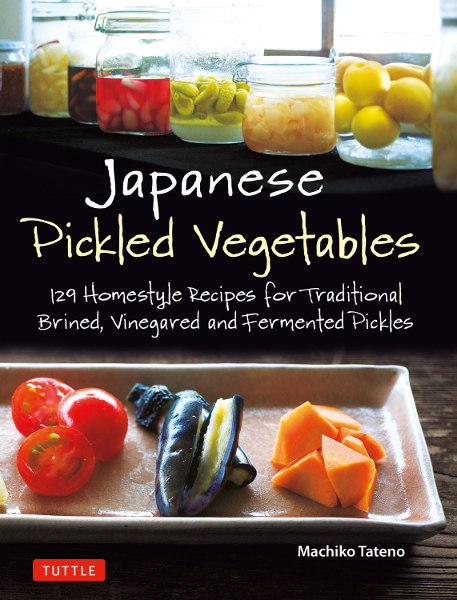
by Machiko Tateno offers over techniques and 120 recipes for tsukemono,
pickled, preserved, and fermented vegetables from asparagus to zucchini.
.
If you have any comments, observations, or questions about what you read here, remember you can always Contact Me
All content included on this site such as text, graphics and images is protected by U.S and international copyright law.
The compilation of all content on this site is the exclusive property of the site copyright holder.
Japanese Pickled Vegetables, a book review
by Machiko Tateno
Thursday, 21 November, 2019
Pickles. If I say "what vegetables are made into pickles" the automatic response is "cucumbers." Well, yes, cucumbers make a wonderful diversity of pickles, using vinegar and spices. You are sterilizing jars and dealing with boiling vinegar. Lacto-fermented pickles don't need boiling vinegar, but they take time. In fact, cabbage, fermented into sour kraut, is one very familiar fermented pickle . Just about any vegetable may be pickled. If you do it yourself, you avoid all those strange, difficult to spell, hard to pronounce, and unknown items on the labels of commercial, store bought pickles
What if your garden or the farmer's market, or even the grocery store has an abundance of top quality produce. And you want to make some pickles. This is where

by Machiko Tateno offers over techniques and 120 recipes for tsukemono,
pickled, preserved, and fermented vegetables from asparagus to zucchini.
You need not be experienced in making pickles to use this book. It begins with an illustrated equipment list that describes the different items. I do have one small quibble: weights suggested for efficiently pressing water out of vegetables includes "bags of flour." Only if the bag of flour were itself in a sturdy plastic bag as leaks of flour or pickling solution would be messy. An illustrated, four page list of ingredients includes a diversity of items from the familiar (cucumber and eggplant) to specifically Japanese (amazake, a fermented rice wine to umezu, plum vinegar.) A recipe for making umeboshi pickled plums is included, so you can make your own umezu. Suggestions for online resources are provided.
The next section, Basics, begins with a discussion of how to make a rice bran pickling bed. It is not difficult, but it is a very different technique than Western readers will be familiar with. There are recipes for using the pickling bed to pickle peppercorns (once you've obtained fresh green peppercorns on the vine) that may then be used to make condiments such as peppercorns in soy sauce. There are brief notes on using the soy pickled peppercorns in sauteed dishes, sauces, and dressings. Another, simplified recipe makes miso marinated garlic. Just 3 ingredients: the garlic cloves, miso, and some mirin, which is sweet rice cooking wine. Combine, and refrigerate anywhere from one week to one month, depending on whether you'll eat the garlic cloves chopped in a sauté or eat them whole.
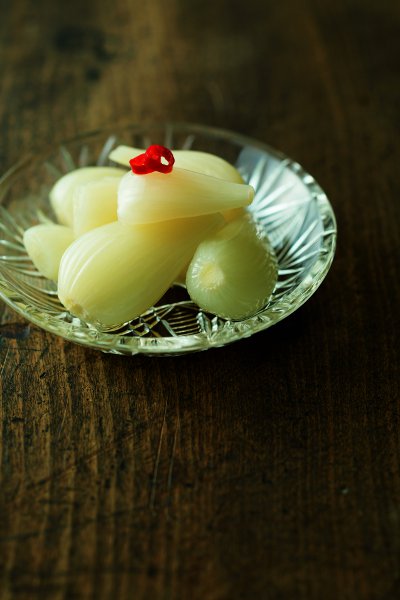
It is interesting than Western pickling recipes are offered as a way to preserve an excess of produce, while many of the recipes in Japanese Pickled Vegetables are small batch, creating pickles intended to enhance a meal. A section on pickled onions uses perhaps a pound or so of small onions. There is sure to be an appealing option, containing as it does variations beyond the basic brined onions to red pickled, spicy pickled, honey ginger, sweet and sour, pickled in sweet vinegar, and even a quick pickled version, shown here. There are just as many recipes provided for pickled ginger. Recipes for kimchi, the traditional Korean pickled Napa cabbage, serving it with fried rice or in a hotpot, either vegetarian or including meat. Kimchi variations where the seasoning paste is used for daikon radish, or bell peppers, even cherry tomatoes.
Numerous recipes for making umeboshi, pickled plums. Not difficult, but tedious what with brining, then drying, then aging for months, or even longer. Next summer, when my local orchard has Shiro plums, I may try the recipe for red pickled plums using red shiso leaves, partly to make my own red plum vinegar.
Shiso is available red or green leaved, easy from seed, and once you grow it, it will reseed.
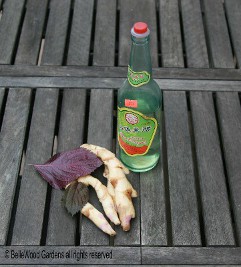 .
.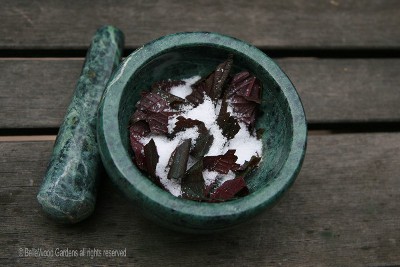
As an aside: I grow red shiso. A while ago I used it to make pickled baby ginger.
The fun part of the book, for me, is Chapter 3, Instant Pickles. There are four sections, by seasons: spring, summer, fall and winter. Here you will find quick and easy recipes, most of which are ready to eat in a day or even less. Even nicer, most of them keep well too, refrigerated of course. Quick cabbage pickles, for example, as simple as cabbage, coarse salt, some kombu seaweed, water, rice vinegar, light soy sauce, a little sugar. Quarter cabbage, salt, bag, and weigh down for 2 to 3 hours. Toss the brine that has formed, add remaining ingredients, massage to mix all together and refrigerate for 12 hours. Other quick pickle recipes deal with a diversity of vegetables such as broccoli rape, asparagus, carrots, even celery. There are also recipes for vegetables you might not be familiar with, such as lotus root and burdock, available in Asian markets.
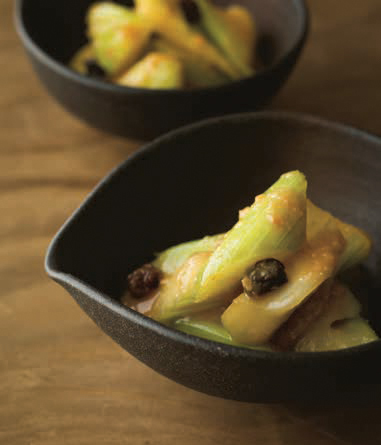
Honey miso pickled celery combines 2 stalks of celery, coarse salt, miso,
a spoonful of honey and - surprisingly - a small handful of raisins. Fast too.
Say 15 minutes to prep the celery, 30 minutes salted, 30 minutes seasoned.
Then serve. This pickle, it is noted, is at its best, served when freshly made.
Many of the vegetables are very familiar, a few are not. Many ingredients may be found in a supermarket, some will need an Asian market or on-line shopping. The recipes have a certain similarity to their techniques. They vary in length of time the salted vegetables are weighted down. Some vegetables are denser than others and need more time. Drain the brine that forms. Add the different seasonings and vinegar. Wait for a few hours to a few days to - for umeboshi plums - a few months, even a year. There are a few fermented pickles too. What the recipes all have to offer is a diversity of options to add a piquant taste to your meals.
The recipe I decided to try is the one for pickled turnips. Why this one? Because I was visiting my friend with a stupendous vegetable garden just a few days ago. And she gave me some white turnips, among other vegetables.
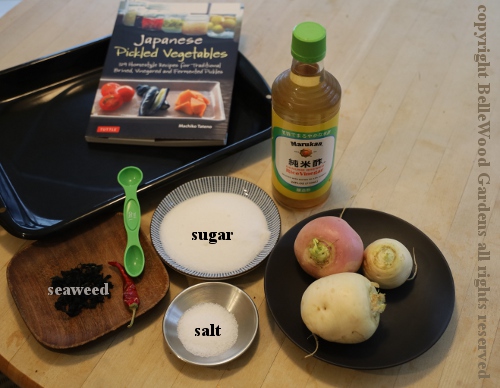
The recipe calls for 2 pounds of turnip but I decided to halve the recipe.
Other ingredients include rice vinegar (different from rice wine vinegar),
white sugar and salt, a dried chili pepper, and a 2 inch square of kombu,
dried seaweed. I happen to have kombu in pieces. I'm sure it will be O.K.
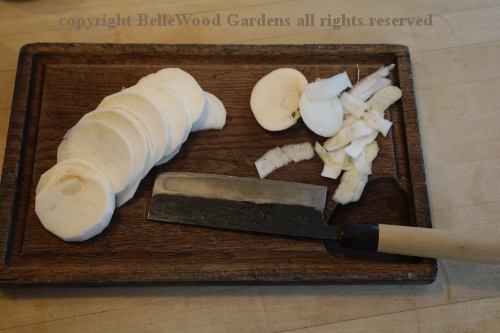
Cut the top and bottom off the well washed turnip, and peel.
Next, slice the turnips into thin rounds. I used a sharp knife.
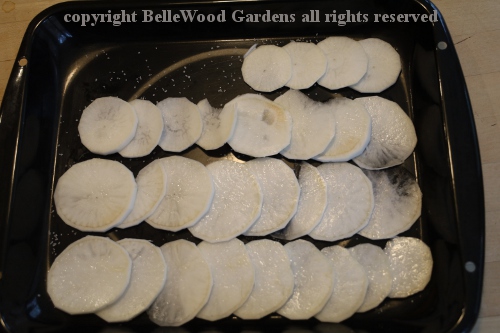
Lay the turnip slices, semi-overlapping, in a metal pan. I used
an enameled broiler pan. A Pyrex pan would also serve. Be sure
whatever you use is non-reactive, because next, the turnip slices
will be sprinkled with coarse kosher salt to draw out some liquid.
Cover the slices with plastic wrap, overlapping the sides of the container. Weight them down - I used a cutting board that fit inside the broiler pan, with some light weights on it. Let sit in a cool, dark place for 4 or 5 hours. Drain off the liquid, then marinate the slices with seasoned vinegar.
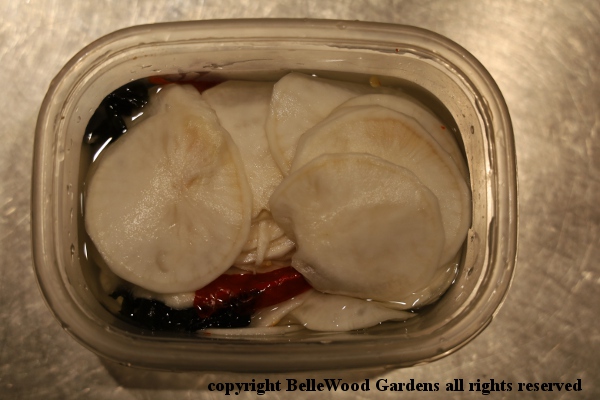
The recipe calls for marinating the turnip slices in a sturdy plastic storage bag.
Instead I decided to use a plastic food container with a tight lid. Layered turnip
slices, tucked the dried red chili pepper pieces along the sides, also the kombu.
Then poured the sweetened rice vinegar over the turnips slices and seasonings.
Note: Rice vinegar is not as harsh as the familiar apple cider or white vinegars.
Now they will sit in the refrigerator for a minimum of 24 hours, after which they are ready to enjoy. They may be kept for up to two weeks, refrigerated.
UPDATE: I made a stir fry for our dinner, with shrimp, broccoli, carrot, and bok choi.
Pickled turnip on the side. Nice crunch, mildly sour taste. Easy recipe, to be repeated.
Japanese Pickled Vegetables
by Machiko Tateno
Published by Tuttle Publishing, Rutland, Vermont, 2019
ISBN 978-4-8053-1530-9, paperback, $16.99
A review copy of this book was provided by the publisher
Back to Top
Back to November 2019
Back to the main Diary Page